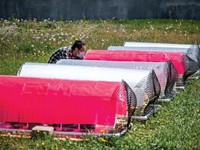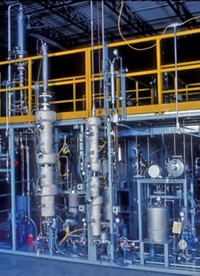Advertisement
Grab your lab coat. Let's get started
Welcome!
Welcome!
Create an account below to get 6 C&EN articles per month, receive newsletters and more - all free.
It seems this is your first time logging in online. Please enter the following information to continue.
As an ACS member you automatically get access to this site. All we need is few more details to create your reading experience.
Not you? Sign in with a different account.
Not you? Sign in with a different account.
ERROR 1
ERROR 1
ERROR 2
ERROR 2
ERROR 2
ERROR 2
ERROR 2
Password and Confirm password must match.
If you have an ACS member number, please enter it here so we can link this account to your membership. (optional)
ERROR 2
ACS values your privacy. By submitting your information, you are gaining access to C&EN and subscribing to our weekly newsletter. We use the information you provide to make your reading experience better, and we will never sell your data to third party members.
Analytical Chemistry
Algae Pump Out Hydrocarbon Biofuels
by Celia Henry Arnaud
September 1, 2008
| A version of this story appeared in
Volume 86, Issue 35

When it comes to biofuels, ethanol from corn gets all the press, but redirecting the photosynthetic process to produce hydrogen or hydrocarbons is another potential source of biofuels.
Plants, cyanobacteria, and algae are all photosynthetic organisms that could be harnessed in this way. Of these, microalgae are the most efficient producers—not surprising considering that as much as 60–70% of each cell's volume is crammed with photosynthetic apparatus, and these organisms don't have roots, stems, or leaves to divert resources.
Anastasios Melis, professor of plant biology at the University of California, Berkeley, is engineering different microalgal species to maximize the generation of hydrogen and hydrocarbons. He described his group's work in a symposium sponsored by the Division of Biochemical Technology.
Although the energy content of hydrogen makes it an attractive fuel, Melis worries about the storage and transport issues associated with hydrogen. He is now investigating whether algae can produce hydrocarbon biofuels. In this context, the hydrocarbons can be viewed as hydrogen stored on carbon, Melis said.
To do this, he is engineering the alga Botryococcus braunii to produce more of the terpenoid C30 botryococcene, a hydrocarbon that is similar to squalene in structure but difficult for cells to metabolize. Instead, the algae secrete droplets of the valuable oil. Melis' team has tinkered with the biosynthetic steps so that the algae produce more of the precursors required to make C30 botryococcene.
Melis' group constructed a large doughnut-shaped polyethylene container to grow large amounts of the oil-secreting algae. They found that in the doughnut container, sunlight doesn't penetrate far into the high-density culture, and the algae beneath the surface are practically in darkness. To alleviate the problem, they engineered algae with smaller light-collecting antennae, which allow more light to penetrate the culture without sacrificing hydrocarbon production. Typically, Melis said, the algal photosystems contain antennae made up of approximately 600 chlorophyll molecules. But the number of chlorophyll molecules can drop to as few as 130, he said. They found that the gene tla1 is key to determining antenna size and is the first such eukaryotic gene to be identified.
ACS Meeting News Highlights
- » Introduction: A Science Sampler From Philly
- Highlights include algae biofuel factories, hunting neutrinos, and more
- » Algae Pump Out Hydrocarbon Biofuels
- When it comes to biofuels, ethanol from corn gets all the press, but redirecting the photosynthetic process to produce hydrogen or hydrocarbons is another potential source of biofuels
- » Untangling Hair Dynamics
- Experimental setup lets researcher tease out tresses' subtle interactions
- » Metal-Organic Liquids Detect Neutrinos
- Chemists have developed new metal-organic liquids to help study the chargeless elementary particles known as neutrinos
- » Tiny Devices Get A Grip
- Tetherless grippers grab and move wee objects






Join the conversation
Contact the reporter
Submit a Letter to the Editor for publication
Engage with us on Twitter